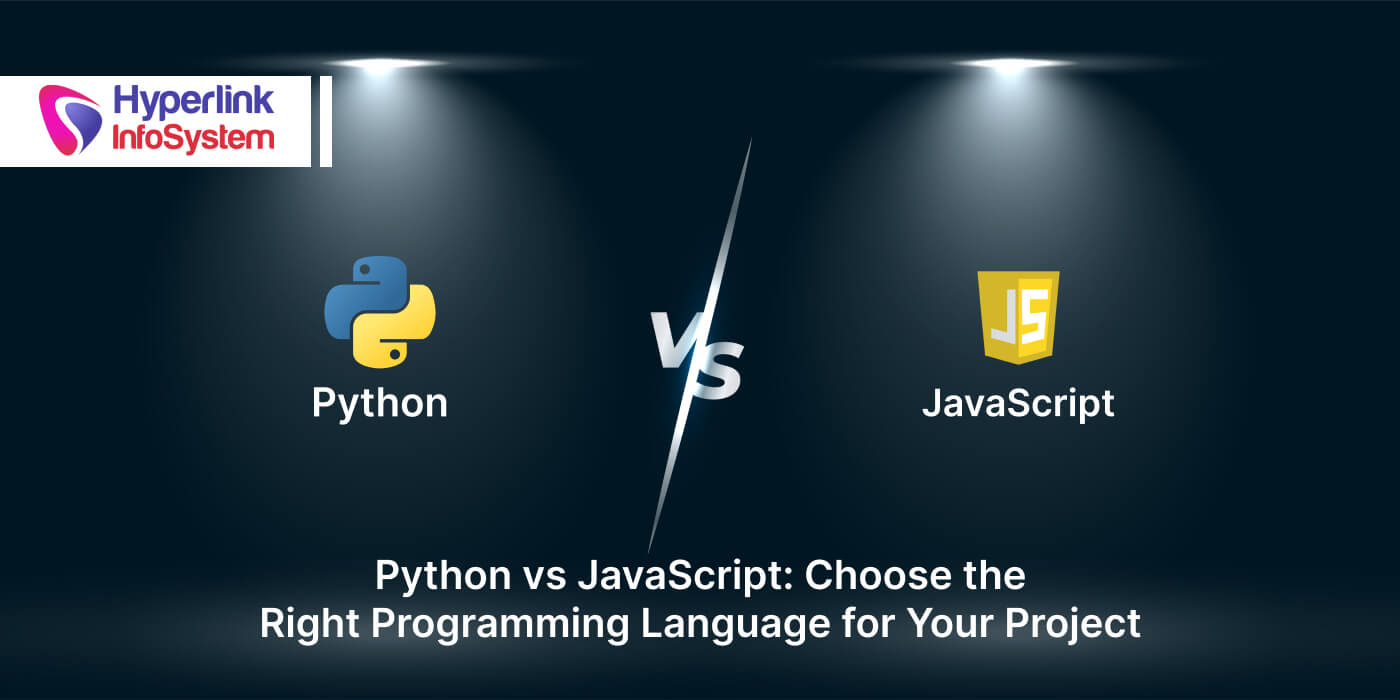Python vs JavaScript: Choose the Right Programming Language for Your Project
Jun 2025

Python is a widely recognized programming language for web development and is increasingly being adopted in data science and machine learning. Meanwhile, JavaScript is the preferred option for front-end, back-end, and mobile app development. We will also take a closer look at the pros and cons, use cases, future trends, and more.
Introduction
Change is the only constant in the software development world. As new tools and frameworks emerge, customer expectations are also ever-evolving. App development companies are under immense pressure to churn out innovative products, which in turn compels developers to up their ante. Python and JavaScript have emerged as pillars of modern development in a vast ocean of programming languages.
In 2025, JavaScript ranks 6th on the TIOBE index with a 3.68% rating. In contrast, Python holds the first position with a 25.35% rating, making it more popular than any other language. With the app development market projected to touch $1489.07 billion by 2029, the competition between programming languages and frameworks is only going to get more intense.
Python may be miles ahead of JavaScript in terms of usage and popularity, but it has its unique value proposition. Also, JavaScript offers advantages that Python can’t match. This blog will serve as a guide for companies that want to choose these programming languages for their upcoming projects.
Why Compare Python and JavaScript?
Python was created for readability and general-purpose programming. It has a clean syntax with minimal code. When we compare JavaScript with Python, it’s clear that JavaScript was built to enhance web pages, making them more interactive while handling dynamic behavior. It employs curly braces to define code blocks and uses semicolons to terminate statements.
While Python and JavaScript have different syntax, structure, purposes, and run-time environments, they do have some similarities. Both are great for beginners and come with vast ecosystems, supporting object-oriented, functional, and procedural programming styles. Additionally, these programming languages often work together in full-stack applications, making them favorites among modern developers.
By comparing these two languages, developers and app development companies can get a clearer perspective. This analysis helps individuals choose which language to learn and understand how it benefits them. Evaluating the features and capabilities of each language can help companies determine the best one that aligns with their project needs.
What Is Python?
Python stands out as a popular language, especially because it is easy to learn. Both developers and companies leverage it to develop software, websites, and apps, all while helping computers understand complex data and make informed decisions. Its syntax closely resembles English, which allows developers to write fewer lines of code and develop outstanding programs.
Key Features of Python
The key features of Python are as follows;
- Free and Open Code
- Easy to Code and Read
- Object-Oriented Language
- GUI Programming Language
- High-Level Language
- Extensive Standard Library
- Robust Community Support
- Dynamically Typed Language
- Easy to Debug
Pros of Python
The pros of the Python programming language are as follows;
- Easy to Learn and Read - Python’s syntax resembles English.
- Versatile Use Cases - From web apps to AI and automation.
- Robust Library Support - Thousands of ready-to-use packages.
- Cross-Platform Compatibility - Ample resources and active forums.
- Ideal for Quick Prototyping - Enables developers to build and test ideas quickly.
- Widely Used in Data Science - Industry-Standard for AI and ML.
- Seamless Integration - Integrates well with other languages and tools.
- In-Demand Skills - Sought-after in sectors such as tech, finance, and education.
- Automation Support - Ideal for writing scripts and bots.
Cons of Python
The cons of Python are as follows;
- Slower Execution - An interpreted language, it's not as fast as compiled ones like C++.
- Not Ideal for Mobile Apps - Python offers limited support for app development.
- High Memory Usage - Less than desirable for memory-intensive tasks.
- Weak in Browser-Side Programming - Does not run in web browsers like JavaScript.
- Runtime Errors - Dynamic typing can result in runtime errors. Bugs appear late due to a lack of type checking.
- Threading Limitations - GIL (Global Interpreter Lock) hinders multi-threading.
- Unsuitable for Game Development - Slower performance compared to compiled languages, while not having the appropriate frameworks.
- Tricky Deployment - Managing the environment and dependencies can be complex.
If you find yourself short on resources or the expertise for machine learning, data engineering, or similar initiatives, consider joining forces with a leading Python development company.
What Is JavaScript?
JavaScript is a powerful programming language that helps developers build websites that are more interactive and engaging. With JavaScript, websites can perform sophisticated tasks like updating social feeds, displaying animations, and allowing users to click buttons and access content without refreshing the page. Lastly, it operates effectively on web browsers, making it a popular choice for building modern websites.
Key Features of JavaScript
The key features of JavaScript are as follows;
- Lightweight Scripting Language
- Supports Dynamic Typing
- Object-Oriented Programming Support
- Functional Approach
- Platform Independent
- Asynchronous Programming
- DOM Manipulation
- Client-Side Variations
Pros of JavaScript
The pros of JavaScript are as follows;
- Enhanced Security for Client-side Apps.
- Light-Weight Language
- Large Community and Several Frameworks
- Supported by Most Modern Browsers
- Ideal for Full-Stack Development
- Easy to Learn and Implement
- Reduced Server Loads
Cons of JavaScript
The cons of JavaScript are as follows;
- Poses security risks if not coded correctly.
- May increase server-side load in some cases.
- Basic debugging tools hinder bug fixing.
- Heavy use of third-party libraries can bloat apps.
- Lacks a multiple inheritance feature.
- Slower rendering compared to other languages.
- Client-side code may be visible and altered by users.
Interested in building interactive websites or game development? Consult a reputed JavaScript development service provider in India.
Python vs. JavaScript - Head-to-Head Comparison
When it comes to choosing between Python and JavaScript, the decision often depends on the skills, expertise, besides project goals and priorities. Both have their share of pros and cons. JavaScript delivers real-time performance and is perfect for interactive websites. Conversely, Python shines in data handling and scalability. Understand that Python is not a replacement for JavaScript and vice versa. In reality, companies that use these programming languages together get the maximum benefits. In this section, we will jump into a direct comparison between JavaScript and Python.
1) Python vs. JavaScript - Performance and Use Cases
Python
- Python is better suited for tasks that require the CPU’s significant processing power.
- It performs well in tasks concerning AI, machine learning, and data analytics.
- Developers can enhance Python’s capabilities by using tools such as Cython and Numpy.
- Python's response time is sluggish for user actions and data updates, making it unsuitable for real-time or highly interactive environments (such as live chat or gaming apps).
- Being single-threaded, using Python may affect concurrency performance (although asynchronous features have improved in the past few years).
- On the bright side, Python’s readable syntax and ease of debugging accelerate development.
- Enables rapid prototyping and shortens the time needed to launch complex products.
- Python’s readability and simplicity make it a collaborative development tool, even for teams with diverse backgrounds and skill sets.
JavaScript
- Ideal for creating dynamic, responsive, and interactive web pages.
- Built into modern native browsers, requiring no additional installations to work. Essential for front-end development.
- With Node.js, developers can run JavaScript on the server while responding to events as they happen (event-driven). Also, the non-blocking I/O feature means JavaScript handles multiple tasks simultaneously without waiting.
- Supports multi-threading via worker threads, enabling completion of multiple tasks in many scenarios.
- JavaScript is usually faster than Python for I/O-bound and real-time apps.
- However, JavaScript can be a bit of a double-edged sword; its loose typing can lead to unmanageable codebases in grand projects.
- To solve this problem, many teams are embracing TypeScript, which enhances code structure, enforces type safety, and makes it easier to maintain over time.
2) Python Vs. JavaScript - Popularity
As per recent developer surveys
- Stack Overflow 2025 - 63% of developers use JavaScript for their projects.
- PYPL Index 2025 - Python holds the number one spot as the most popular programming language.
- TIOBE Index 2025 - As of now, Python is reigning supreme as number one with 25.35% ratings, highlighting its contributions in education, data science, and backend development.
It's safe to say that Python is the most popular language in 2025 for data science and back-end related projects. That said, JavaScript is still going strong as a web development favorite.
3) Python Vs. JavaScript - Scalability
Node.js is designed for scalability. Not only does it handle multiple requests concurrently, but its worker threads and clustering features use CPU cores effectively. This makes it ideal for horizontal and vertical scaling.
- JavaScript can easily be scaled across multiple systems. It also facilitates scaling within a server through additional resource allocation.
- In this way, JavaScript is excellent for high-load, distributed systems like chat apps, real-time dashboards, and streaming platforms.
- Alternatively, running a Python program using threads is not beneficial because the GIL limits multi-threading. A single thread can only execute one code at a time.
- To counter this problem, developers can use multiprocessing to run tasks in separate processes.
- Also, tools like Celery and Dask can assist with large workloads or background tasks.
- Overall, JavaScript offers better scalability compared to Python. It's not like Python is not scalable. Python does offer scalability, but achieving performance and concurrency requires additional tools and architectural planning.
4) Python Vs. JavaScript - Learning Curve
- Due to Python’s clear syntax and simplicity, beginners can grasp it easily and work on development projects.
- We cannot say the same for JavaScript, which has a steeper learning curve due to its inconsistent behavior, prototypical inheritance and asynchronous programming challenges.
- ECMAScript 6 and newer versions of JavaScript have introduced new features, making development more straightforward. Still, JavaScript’s underlying design remains unchanged, which makes learning slower and challenging for beginners.
5) Python Vs. JavaScript - Inheritance
- In Python, when developers create a class, they usually begin with a parent class and then create a child class. This class-based, object-oriented inheritance is quite easy to wrap your head around because it reflects how things work in the real world.
- On the flip side, JavaScript employs a prototype chain for its inheritance, which can get fairly complicated. Before 2015, JavaScript had no classes; it used prototypes.
- With the E6 update, JavaScript introduced a class feature to mimic Python, but behind the scenes, it still uses prototypes.
- In conclusion, Python’s inheritance is simpler and easier to understand, while JavaScript gives us the illusion of a class-based system. It’s deeply rooted in an older mechanism that is not beginner-friendly.
6) Python Vs. JavaScript - Modules and Libraries
- Python has an extensive standard library. It comes with an inbuilt, rich set of modules, allowing developers to do more without additional installations.
- With Python, developers can perform multiple tasks such as file operations, networking, JSON/XML, parsing, unit testing, and more. All they need is a standard Python install.
- On top of that, the Python Package Index (PyPI) features a rich archive of third-party libraries. Developers can tap into these resources to install specialized tools for AI/ML, data science, and automation.
- In this way, Python is excellent for tasks that require an innovative mindset, especially for scientific, automation, and data-driven projects.
7) Python Vs. JavaScript - Numeric Types
- Python supports multiple numeric types such as int, float, complex, and decimal. It also allows arbitrary precision integers, making it exceptionally valuable for scientific and finance-related tasks.
- Previously, JavaScript only used 64-bit floating-point numbers. One could represent integers and decimals, but handling large integers while ensuring accuracy was a challenge.
- Another disadvantage was that it was ineffective for scientific computing or binary processing-related tasks.
- Post-2025, JavaScript supports additional numeric types, enhancing its efficiency in handling different numeric use cases.
- JavaScript has an edge over Python in this aspect because it can handle complex numeric tasks with greater efficiency and accuracy (thanks to BigInt and TypedArray).
8) Python Vs. JavaScript - Implicit Conversions
- JavaScript is weakly typed. It automatically converts data types when it thinks it's appropriate. Such implicit type coercions provide greater flexibility, but they may result in undetected bugs if not used correctly.
- Unlike JavaScript, Python does not convert data types automatically. It is dynamically and strongly typed. If a developer mixes incompatible types, Python raises an error.
- JavaScript is more flexible, but it can cause errors. Python is rigid but avoids type-related errors.
9) Python Vs. JavaScript - Mobile and Web Development
JavaScript is a powerhouse for web development, especially with tools and frameworks such as React, Vue, Angular, and Node.js at its disposal. Developers turn to JavaScript to craft high-performance, scalable apps. It is also a great option for mobile app development thanks to tools such as React Native and Ionic.
In contrast, Python does not quite measure up for mobile apps, although it can still create GUI and cross-platform apps using Kivy, BeeWare, or PyQt. Where Python shines is in backend web development with frameworks such as Django and Flask.
So, if you need something for web and mobile UIs, JavaScript is the way to go, while Python is better suited for back-end tasks, automation, and data-driven services.
Python Vs. JavaScript - Development Costs
Below are some of the approximate development costs for Python and JavaScript. These figures are just to give you an approximate idea. Consult a reputed app or web development company for precise details.
|
Factor |
Python |
JavaScript |
|
Average Hourly Rate |
$40 - $100 (varies by region/skill) |
$35 - $90 (higher availability of developers) |
|
Talent Availability |
Moderate (esp for senior roles) |
Abundant (large pool of full-stack developers) |
|
Development Speed |
Fast for backend and scripts |
Fast for full-stack and full-stack ready |
|
Maintenance Costs |
$4,000 - $15,000/year |
$5,000 - $20,000/year (depends on framework complexity) |
|
Tooling and Libraries |
Free and Mature (Django, Flask, and FastAPI) |
Free and Extensive (React, Vue, Node.js) |
|
Hosting Costs |
$20 - $200/month (example cloud VPS, Heroku for APIs) |
$5 - $100/month (serverless, static, or JAMstack hosting options) |
|
Best Suited For |
Ideal for machine learning, data science, APIs, and automation |
Best for web, real-time, and hybrid mobile apps |
|
Cross-Platform Development Cost |
$10,000 - $50,000 (Requires JS bridge or niche frameworks like Kivy) |
$5,000 - $25,000 (React Native, Ionic, and Electron available) |
|
Time to MVP |
2 to 6 weeks (depending on the complexity) |
2 to 5 weeks (fast for full-stack, web/mobile apps) |
JavaScript Vs. Python - Use Cases
Below are some use cases of JavaScript.
- Web Development (front-end and backend with Node.js)
- Interactive UI/UX (animations, DOM manipulation)
- Mobile apps (React Native, Ionic)
- Desktop Apps (Electron)
- Game Development (Browser-Based Games)
- APIs and Real-Time Apps (e.g., chat and notifications)
Below are the use cases of Python
- Data Science and Machine Learning
- Automation and Scripting
- Web Development (Django, Flask)
- Backend Services and APIs
- AI and NLP Apps
- Cybersecurity and Penetration Testing
- Game Development (Pygame)
- IoT and Embedded Systems
Python Vs. JavaScript - When to Use It?
Python and JavaScript both have their unique strengths and weaknesses. It is not quite right to say that one is better than the other. Depending on the project at hand, developers may find Python a better option for some projects, and the same can be true for JavaScript. What to use Python and JavaScript for?
Python
Projects related to data science, AI/ML, automation, backend development, or rapid prototyping. Its clean syntax and extensive libraries make it perfect for quick and efficient problem solving.
Thinking about hiring Python developers for your next project? Start by understanding the project requirements. Clearly outline the kind of Python developers you need for the project, and explore the right avenues to find them.
JavaScript
If you are looking to develop interactive web apps, front-end interfaces, or programs with real-time features such as chats and notifications, JavaScript is the way to go. It is a core component of many browsers and pairs well with JavaScript frameworks like React, Vue, and Node.js, allowing for seamless full-stack development.
All in all, Python is the top pick for tackling complex, analytical tasks, whereas JavaScript has the upper hand when it comes to creating dynamic and user-friendly experiences. Before you hire a JavaScript developer, evaluate their experience, technical skills, and whether they are the right fit for your industry.
Python and JavaScript - What the Future Holds
Python and JavaScript rank as two of the most popular programming languages out there. Companies often rely on Python for machine learning capabilities, whereas JavaScript has the upper hand when it comes to crafting dynamic and interactive web experiences.
The software development industry is buzzing with exciting trends such as artificial intelligence, cloud computing, and enterprise apps. It would be interesting to see how Python and JavaScript fit into and enrich this altered landscape. Below are some of the future possibilities for Python and JavaScript.
Python Future Outlook
AI and Data Science
Still the top language for AI, machine learning, and data science because of Python’s vast libraries such as TensorFlow, PyTorch, pandas, and scikit-learn.
Advanced Integrations
- Quantum Computing - Making headway via libraries like IBM’s Qiskit.
- Edge and IoT - MicroPython and CircuitPython enable Python to run on microcontrollers.
- WebAssembly (Wasm) - Pyodiede enables Python to run directly in web browsers, similar to JavaScript. This makes it possible to enable interactive apps without the need for a server.
Performance Improvements
- Python 3.12 and newer versions deliver better performance, which includes faster startup and reduced memory usage.
- Projects like Mojo are a great initiative to combine Python’s ease of use with C-level speed.
Scripting and Automation
Remains a top pick for automation and DevOps, frequently used in cloud orchestration (AWS Lambda, Azure Functions)
JavaScript Future Outlook
Expanding Ecosystem
JavaScript and TypeScript play a crucial role in front-end and full-stack development. Plus, frameworks like React, Vue, and Next.js are evolving at a breakneck pace.
WebAssembly Integration
The combined power of JavaScript and WebAssembly brings desktop-level performance to the browser. Thanks to this, advanced browser games, 3D modeling tools, or in-browser machine learning work with greater speed and efficiency.
Serverless and Edge Computing
JavaScript is the predominant language for serverless functions and edge computing, especially for AWS Lambda and Vercel.
AI in the Browser
Leveraging tools like TensorFlow.js and ONNX.js, JavaScript can run AI models within the browser, and that too without the need for a server.
Tooling and Language Evolution
Ongoing bundler improvements, such as Vite, esbuild, along with ECMAScript updates and TypeScript adoption, facilitate better coding with Java while improving reliability.
Final Thoughts
Developers who have just stepped into the world of web development should consider grasping the ins and outs of HTML, CSS, and JavaScript. Once they master these front-end languages, creating interactive websites becomes a cakewalk. On the other hand, aspiring data scientists, researchers, and academics, plus cybersecurity and automation enthusiasts, can opt for Python.
Be it Python or JavaScript, each has its advantages and limitations. Depending on the project requirements, web and app development companies choose the right programming language for their specific needs. That said, many developers interoperate JavaScript and Python using RESTful APIs, microservices architecture, in-browser Python, and server-side scripting.
Not only does this interoperability tap into the strengths of both languages, but it also gives developers access to a wider range of tools, leading to greater productivity and performance.
The Python Vs. JavaScript debate will never end, but if you’re looking for an esteemed web development company for your next project, we are here to serve. Connect with one of Hyperlink InfoSystem’s experts to see what we can do for you.
Schedule a Consultation Today!
Frequently Asked Questions
You cannot afford to underestimate the importance of Python in machine learning. It is the backbone for everything from data analysis to building and deploying models. No wonder Python is a clear frontrunner in the machine learning community. Below are the main reasons for Python’s growing popularity.
- Clear and readable syntax facilitates better learning and use. Allows data scientists and researchers to focus on problem-solving rather than learning a new programming language.
- Rich libraries and frameworks are ideal for data science and machine learning tasks.
- Supports object-oriented, procedural, and functional programming, providing greater flexibility for designing and organizing ML workflows.
- The abundance of documentation and community support ensures better learning and project completion.
- Integrates effectively with other tools and platforms, especially Jupyter Notebooks, which are key to exploratory data analysis and model prototyping.
- Works effectively with cloud platforms and deployment tools.
Some of the top JavaScript frameworks include React, Vue.js, Angular, Svelte, and Next.js. Out of all these frameworks, React is the most popular choice for developers. Besides its popularity and widespread usage, it offers robust community support while integrating with advanced tools. However, developers choose Vue and Svelte for faster and straightforward development, while Angular is the top choice for developing complex, enterprise-grade apps.
- Many people ask - What is the role of JavaScript in software development? To answer this question, consider the role of JavaScript in software development as being like the electric wiring in a house. It powers the dynamic and interactive features of web pages and applications. Comparing JavaScript and Python for software development is like comparing apples and oranges.
- If developing interactive websites, full-stack web apps, or real-time apps is the ultimate goal, JavaScript is the best choice. For data science, backend-intensive systems, or automation projects, Python would be a better option.
Web development services cover front-end, backend, and full-stack development along with UI/UX design and maintenance support. As JavaScript works on the frontend and backend, developers can use it to develop entire web applications using a single language. Whether it's designing the UI or handling data and business logic on the server, web development holds the key.
Should I hire JavaScript developers from India? You may have heard this question a million times. Yes, companies that want to save money and develop world-class apps and websites should consider hiring Python developers in India. The benefits are as follows.
- Availability of developers at affordable rates.
- Vast pool of skilled and experienced developers.
- Proficiency in modern JavaScript tools and frameworks.
- No communication barrier as Indian developers are proficient in English.
- Work across multiple time zones for greater productivity.
- Quick adoption of new technologies and latest trends.
- Access to developers with full-stack JavaScript expertise.
- Proven track record in delivering top-notch software solutions.
Whether it's hiring Python developers in India, JavaScript specialists, UI/UX designers, data scientists, cloud architects, IoT, or AI/ML engineers, India has no shortage of talent. Hire the right team, and the results will speak for themselves.
Latest Blogs

Is BlockChain Technology Worth The H ...
Unfolds The Revolutionary & Versatility Of Blockchain Technology ...


IoT Technology - A Future In Making ...
Everything You Need To Know About IoT Technology ...

Feel Free to Contact Us!
We would be happy to hear from you, please fill in the form below or mail us your requirements on info@hyperlinkinfosystem.com
Hyperlink InfoSystem Bring Transformation For Global Businesses
Starting from listening to your business problems to delivering accurate solutions; we make sure to follow industry-specific standards and combine them with our technical knowledge, development expertise, and extensive research.
4500+
Apps Developed
1200+
Developers
2200+
Websites Designed
140+
Games Developed
120+
AI & IoT Solutions
2700+
Happy Clients
120+
Salesforce Solutions

40+
Data Science

















